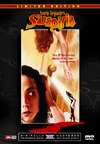Suspiria
Anchor Bay Entertainment
Cast: Jennifer Harper
Extras: Documentary, Theatrical Trailers, TV Spots, Radio Spots, Music Video, Still Gallery, Talent Bios
Rating:
On paper, the story of "Suspiria" is fairly easy to explain. A young American ballet dancer named Susy Banyon arrive in Freiburg, Germany to study at a world renowned dance academy. On the night that she arrives at the school, one of the students in murdered (In a scene which must be seen to be believed.), and Susy can’t get into the school. The next day, she is properly welcomed into the Academy by the director Madame Blanc (Joan Bennett) and her teacher Miss Tanner (Alida Valli). During the first class, Susy falls ill and faints. Despite the fact that she’d planned to stay in a nearby apartment, Madame Blanc insists that Susy live at the school until she feels better.
While that synopsis seems straight-forward and simple enough, seeing "Suspiria" unfold on-screen is another matter entirely. You see, "Suspiria" isn’t about the story, it’s about visuals. I would say that the narrative takes a back-seat to the visuals, but at times it’s as if they aren’t even in the same car. Argento lets just enough of the story sneak in so that he can create his shots. And, oh, what shots they are. "Suspiria" was one of the last films to be shot using the old Technicolor Three-Strip film process. This is exactly what it sounds like. There are actually three strips of film running through the camera, each photographing a separate color spectrum. During development, the three strips are put together, giving us an image of unsurpassed color. With this process, Argento and director of photography Luciano Tovoli were able to paint a color palette the likes of which have never been seen before (or since) in a horror film. "Suspiria" is dominated by reds, blues, and greens creating an entirely new and eerie world. This color scheme only adds to the nightmarish quality of the film. While some have described "Suspiria" as a dark fairy-tale (indeed Argento calls it this), I prefer to view the film as if you are watching someone else’s bad dream.
This unique color technique is accentuated by Argento’s creative camerawork, which filmmakers such as John Carpenter have acknowledged as being inspirational. The camera here is rarely still, as it roams the halls of the dance academy or of the apartment building at the beginning of the film. When the camera is still, Argento shoots through light-bulbs, glasses, and sheets to give the film a very unique feel. Argento also alternates using extreme close-ups and long-range shots (as in Chapter 15). The camerawork, combined with the colors, make "Suspiria" one of the most visually unique films ever made.
Given the visual reputation of "Suspiria" one would hope that the DVD would be impressive, and those prayers are answered with the new DVD from Anchor Bay, which features a new transfer which was supervised by Argento and Tovoli. The film is presented in an <$16x9,anamorphic> <$PS,widescreen> and has been <$PS,letterboxed> at 2.35:1. This <$THX,THX>-certified transfer looks fantastic and beats any previous transfer hands down. The image is razor-sharp and very clear, showing only the slights amount of grain during the outdoor scenes. There are no noticeable defects from the source print. The framing appears to be accurate, and there is no artifacting effects present. Of course, the colors are outstanding, showing none of the halos which appeared on the lasersdisc edition. The reds, blues, and greens simply leap off of the screen, while at the same time adding a great deal of depth to every shot. Even if you’ve seen "Suspiria" several times, you’ve never seen it like this.
Anchor Bay has also done a great job with the extras. The DVD includes two theatrical trailers. The international trailer is <$PS,letterboxed> at 1.85:1, and has to be one of the weirdest previews ever, as it only features tinted still frames from "Suspiria". The U.S. trailer is also <$PS,letterboxed> at 1.85:1, and is a great example of cheesy horror film promotions from the 1970s. (You’ve got to love the breathing letters!) There is also a full-frame TV spot, which was culled from the U.S. trailer. We next have three 30-second radio spots, which are all quite entertaining. There is a still-gallery, which features 97 images. Most are production stills from the film, but there are also many posters and other ad art for "Suspiria" from all over the world. The cast and crew section contains detailed biographies for Argento, co-writer Daria Nicolodi, and star Jessica Harper. Finally, we have a music video by the band Daemonia, who do their own version of the "Suspiria" title song. This video is just plain weird. (Am I going to hell for watching that?)
Fans of "Suspiria" have been waiting a quarter-century for the definitive version of the film and it’s finally here. This DVD should satisfy any Argento’s fan quest for a perfect transfer and for knowledge about the film. The audio and video presentation here is exquisite and does justice to the film’s reputation for providing unique sights and sounds. "Suspiria" may still be confusing to some, but there’s no question that this DVD is superb.







